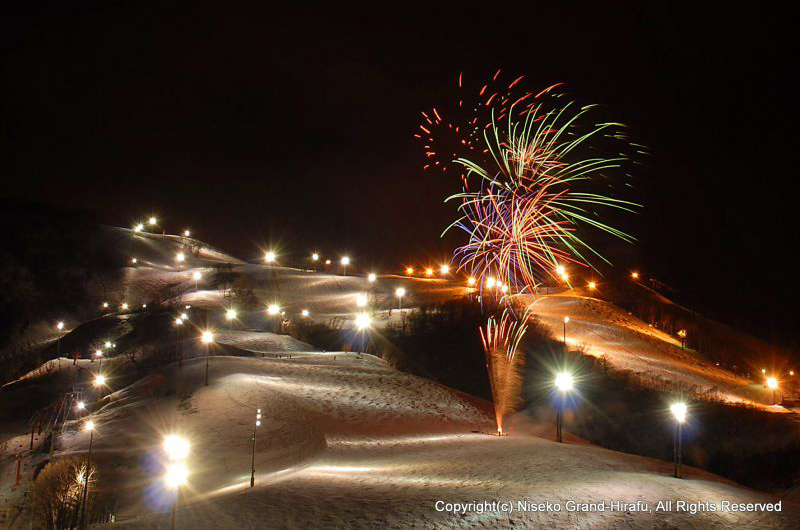December, 18th 2018

The Japanese love a good celebration, and New Year is one of the biggest. Find out a little more about the culture and tradition behind Japan’s end of year celebrations.
Christmas in Japan
Being a country with a very small Christian population, Japanese Christmas doesn’t take on the same religious connotations as in Western society, however take a trip to Japan over the Christmas period and you’ll still find many of the things traditionally associated with Christmas – festive light displays, Christmas markets, Christmas trees in shopping malls… You’ll also find a few uniquely Japanese traditions.
Gifts
Unlike the whole-family present opening sessions most Western households may be used to on Christmas Day, in Japan the gift exchange is usually just between couples and is done on Christmas Eve. Families will usually save the present-giving for New Years, which is a much bigger celebration (more on that soon!). Workplaces will often have a “Secret Santa” style gift exchange amongst co-workers, known as oseibo.
Christmas Cake
When you think Christmas cake, you probably think fruit cake or pudding, right? Well in Japan they have their own version of a Christmas cake. Although not strictly a Christmas-only treat, most stores will sell Strawberry Shortcake around Christmas time – a light sponge cake with whipped cream and strawberry filling and frosting.
Christmas lights
The Japanese love a good light display, and they sure do it well! Around Christmas time you’ll find stunning lighting displays in major shopping strips and malls as well as public parks such as Odori in Sapporo City. Otaru (about an hour from Niseko) has a great display all through December and January, and in Niseko you’ll find light displays at JR Niseko Station in Niseko Town as well as small displays throughout all the resorts of Niseko United.
New Years
New Years, known as oshogatsu is the most important holiday in Japan. It’s a time for families to get together and celebrate, and most businesses will close for a few days. If you’re in Japan around this time you’ll likely see oshogatsu decorations outsides homes and businesses – They usually feature branches of pine tree, which symbolizes longevity and good luck, and bamboo which is a symbol of good health and resilience. Some of the decorations might also feature fruit such as mikan (Japanese mandarines) or the red berries of the plant called senryo (literally “a thousand coins”), which are symbols of wealth and prosperity.
New Years Eve
This is a time for a traditional family dinner, usually osechi, which is made up of many small dishes that have important meanings for being served. Soba (buckwheat noodles) are also served and signify long life and happiness. At midnight, a visit to the shrine is often made to ring in the new year – this first visit of the new year is called hatsumode.
New Year’s Day
A popular tradition is to watch the first sunrise of the new year, known as hatsuhinode. Another significant ceremony is the kagami biraki – translated as “opening the mirror” in reference to the transition from one stage to another – which involves breaking open a sake barrel with wooden mallets and also pounding mochi (rice cakes).

You can experience some of these traditional events yourself if you’re in Niseko for Christmas or New Year. Check out our guide to events for more details.
Important notice about slope access
Niseko Village ⇔ Hanazono access on skis unavailable from April 1st Starting on April 1st 2025, it is not possible to move between Niseko Village ...
1 April 2025
The Most Instagrammable Spots in Niseko United and Beyond
With warmer temperatures, sunnier days, and fewer crowds on the slopes and around town, it's the perfect time for both casual phone photographers and...
25 March 2025
Sustainable Slopes: Reusing Lift Tickets for a Greener Future
Exciting News for Eco-Conscious Skiers and Snowboarders! We're thrilled to announce a new initiative that aligns with our commitment to environmen...
15 March 2025
Niseko Season Update
What a winter it’s been so far in Niseko! From world-class lift upgrades to record-breaking snowfall, unexpected sunny spells, and classic powder day...
25 February 2025
Spring in Niseko: Why It’s The Perfect Time To Visit
You're probably reading this article on a mid-winter day, but before you know it, sunny skies, quieter slopes, and soft spring riding conditions will...
5 February 2025
Night Skiing is OPEN in all 4 Resorts!
Imagine this: after skiing since the first chair and enjoying fresh turns all day, it's still snowing and the sun is setting, but you're hung...
21 December 2024
Here’s What’s New This Winter at Niseko United
As we prepare for another epic season in your favorite winter resort destination, be sure to check out what's new this holiday season and beyond! ...
27 November 2024
Winter Season Outlook 2024-25
The question on everyone’s minds leading up to winter… What’s the snow outlook for the 2024-25 season? Last winter saw average snowfal...
5 November 2024
What Do Niseko’s Winter Resort Staff Do in the Summer?
Hikari Suzuki - Lift Operator from Tokyo Are you a summer person or a winter person? I'm an all-season person! What job did you ...
29 August 2024
Your Itinerary For Niseko In Autumn: Foliage, Food, & More
While mainland Japan is still scorching hot, temperatures are starting to cool in Niseko as the footsteps of Autumn draw near. Niseko’s ...
27 August 2024
Unleash Your Inner Tarzan: Tree Trekking in Niseko’s Summer Wonderland
Niseko is famous for the world’s best tree skiing in winter, but come summer and those same trees provide another thrilling adventure for green s...
1 August 2024
Niseko’s Transformation From Winter Wonderland to Water World
Niseko gets buried under 10-15m of snowfall every winter, but what happens when the weather warms up and all that snow melts? Niseko transforms i...
29 July 2024
Niseko’s Vibrant Summer Festivals & Events This Green Season
Mountain Lights And Fire Goddess Performance When the weather heats up in Niseko, it’s time to get outdoors and celebrate the summer – and tha...
29 June 2024
Grand HIRAFU Connects with Twin Peaks Mountain Bike Park
*Trails illustration is an Approximation showing current, planned and proposed Phase 3 trails. Photo: Glen Claydon Big news for the Niseko mou...
29 June 2024
Niseko, the New Mecca Of Mountain Biking
Now known around the world for its powder snow and ski slopes, Niseko is transforming itself into a green season mecca of mountain biking. Develo...
29 May 2024
8 Things To Do In Niseko This Summer
Although not as many people know about Niseko's summer season compared to its winter, it is filled with sprouting greenery, picturesque scenery, ...
29 May 2024
SUBSCRIBE TO OUR NEWSLETTER






Copyright © 2019 Niseko United.日本語